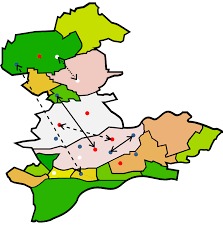2021
‘Grid’ statistics
Counting at 'grid square level' is new for this census and contains much more detailed information than at municipal level. The grid of 1 by 1 kilometre squares cuts right through municipalities, but also needs to match our national borders. The advantage of this grid is that - unlike municipal boundaries - it remains stable over time.
The grid method makes it possible to compile comparable statistics for grid squares across the whole of the EU, even those that cross national borders. The squares remain consistent over time and are not affected by things like municipal border changes. To comply with the stricter data protection regulations (GDPR, 2018), CBS worked with a number of statistical offices in other countries to develop new statistical disclosure control methods and software.
On 1 January 2021, nearly 33 thousand grid squares in the Netherlands were inhabited by 17.5 million people. For each grid square, CBS calculated how many people lived there, how many men and women, how old they were and where they were born, how many people had a job and how many people had moved home in the previous year.
The census data were sourced from the Municipal Personal Records Database (BRP) and the System of Social Statistical Datasets (SSB). Data from the Educational Attainment dataset were also included; CBS had still had to estimate education levels for the population for the 2001 and 2011 censuses.

Data delivery
In January 2024, CBS started trial runs for the 2021 census. Eric Schulte Nordholt, census coordinator at CBS: ‘Using data from 2017, we checked whether all the procedures worked and whether the quality of the outcomes was high enough.’
The 2021 census data have to be delivered to Eurostat by 31 March 2024.